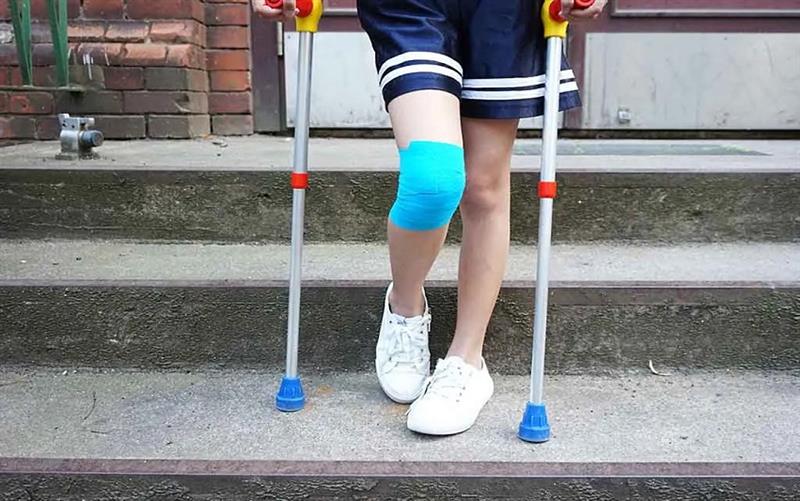
The right approach to use crutches can significantly impact how quickly your injury recovers and help you prevent further ailments like shoulder soreness. This article offers instructions on how to walk with crutches while not bearing weight, while doing so partially, and while only using one crutch. Additionally, it offers guidance on how to imitate your regular gait pattern to hasten your rehabilitation.
Standard Crutches
While using crutches to move around:
- Put less weight on your armpits and more on your palms.
- When walking, keep your gaze up and not at your feet.
- Sit and stand more easily by using a chair with armrests.
- Verify that the crutches are positioned according to your height. The top should be between 2.5 and 4 centimetres (1 to 1 1/2 inches) below your armpit. Hip level is where the handles should be.
- When you grasp the handles, your elbows should be slightly bent.
- To avoid falling, keep the tips of your crutches about 3 inches (7.5 centimetres) away from your feet.
When not in use, rest your crutches upside down to prevent them from falling over.
How to use a one crutch while walking
You might be able to get away with using just one crutch for some injuries. Additionally, since there is only one crutch, you will only be partially supported.
Which side is superior for walking when using a crutch? Since we normally walk with our opposing legs and arms moving forward simultaneously, it is best to utilise the crutch on the side that is not injured.
In order to distribute your weight-bearing between the crutch and that leg, you would place the injured side and the crutch on the ground simultaneously. Maintaining the "shadow walking" stride is also important here.
However, I have seen individuals who simply were unable to use the opposite side of their crutch to walk. Simply use the crutch on the side that is damaged if you are like that and really unstable. Although it isn't ideal, it is preferable to the possibility of falling.
Partial Weight-Bearing While Crutching
It's crucial to keep your crutches close to your sides and tucked under your arms when using them to walk. Put weight on your hands rather than your armpits and squeeze the top of the crutches into your sides. Do not rest your armpits on the crutches.
Crutches should be advanced six to twelve inches. You move forward on your damaged leg, pressing down on the handgrips as you do so. Put the specified weight on the leg that is hurt. Next, move your sound leg through. Always let the wounded leg go through before the healthy one. Crutches front, damaged leg forward, then step through with the healthy leg is how to walk with crutches properly.
You might need to use crutches if your accident or surgery prevents you from bearing any weight on your leg or foot.
Suitable Positioning
- The top of your crutches should be 1-2 inches below your armpits when you are standing straight.
- The top of your hip line should be parallel to the hand grips of the crutches.
- Holding the handgrips should be done with your elbows slightly bent.
- Your weight should be supported by your hands, not by the underarm supports, to prevent harm to the nerves and blood vessels in your armpits.
Walking
- Put your crutches about one foot in front of you while leaning slightly forward.
- Step forward as though you were going to use the damaged leg or foot, but shift your weight to the crutches instead.
- Slowly advance your body between the crutches.
- Use your strong leg to complete the step normally.
- Move your crutches forward in anticipation of your subsequent step after your healthy leg has touched the ground.
- Never glance down at your feet; always gaze forward.
Sitting
To sit:
- Return to a stable chair.
- As you hold both crutches in one hand, position your damaged foot in front of you.
- To locate the seat of your chair behind you, use the opposite hand.
- Lower yourself into the chair gradually.
- Lean your crutches against a nearby wall once you are seated. Crutches often topple over when resting on their points, so make careful you lean them upside down.
To get up:
- Move closer to the chair's front.
- On your wounded side, hold both crutches in your hand.
- Get up and stand on your strong leg.
Stairs
You must be strong and flexible to use crutches to climb and descend stairs. At least initially, you might want assistance.
- Hold the handrail with one hand while facing the stairs, and on the other side, tuck both crutches under your armpit.
- Lead with your healthy foot as you climb, keeping your damaged foot high behind you. Hold your wounded foot up in front as you descend, and take each step down with your healthy foot.
- Consider each step as it comes.
- Use the crutches under both arms and jump up or down each step on your good leg if you come across a stairwell without handrails.
It can be simpler to sit on each step and ascend or descend on your bottom if you're feeling wobbly.
- Sit down on the bottom step first, extending your afflicted leg in front of you.
- With your opposite hand, place both crutches flat against the stairway.
- Utilising your free hand and strong leg as props, scoot your bottom up to the following step. When you down the stairs in this manner, keep facing the same way.